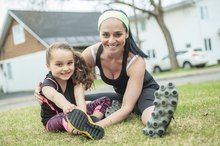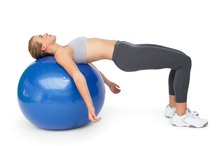Trunk-Strengthening Exercises for Infants
Sitting up, crawling, standing and walking are all exciting milestones in your infant's life. With each new milestone, your little one is getting stronger and developing. Help him grow by including exercises in your routine that help encourage muscle strength and nervous system adaptations that lead to development. The trunk includes the muscles of the stomach and back. Exercising your infant's trunk muscles can help him ease into these exciting milestones.
Ball Exercise
Use an exercise ball to encourage trunk strength development 2. When your child is developed enough to sit up on her own, perform this simple exercise. Hold her as she sits on top of the exercise ball. Position your hands with your thumbs and pointer finger supporting your child on her thighs with the rest of your hands on the ball. Encourage your baby to bounce on the ball. When she looks comfortable and has her balance, slowly move the ball around in each direction to force your child to use her trunk muscles to keep her balance.
- Use an exercise ball to encourage trunk strength development 2.
- When your child is developed enough to sit up on her own, perform this simple exercise.
Tummy Time
Things to Do with a 10-Month-Old
Learn More
Tummy time is a simple thing you can do to encourage crawling and help your infant increase his upper back, neck and stomach strength. To make the most out of tummy time, place toys around your baby so that he has to reach for them. Play with your baby in front of him so that he must lift his head and support himself with his arms. Encourage tummy time for just small increments of time, dictated by your baby. He will let you know when he is too tired or not in the mood. As he gains strength, tummy time will increase in length.
- Tummy time is a simple thing you can do to encourage crawling and help your infant increase his upper back, neck and stomach strength.
Flexion
Trunk flexion is the act of bending at the hips to sit up from a lying position. This takes trunk strength and marks a developmental milestone 23. To increase trunk strength, lie your baby on her back on a solid surface. Gently grab her hands in yours and lift her torso up off the floor into a sitting position. Gradually you will feel your little one using more of her muscles -- rather than your support -- to sit up. Perform this exercise only when your baby is strong enough to support her own neck.
- Trunk flexion is the act of bending at the hips to sit up from a lying position.
- Perform this exercise only when your baby is strong enough to support her own neck.
Rotation
Posture Exercises for Kids
Learn More
Rolling over takes a lot of strength. Help your little one build up the trunk muscles for this feat with a little exercise. Any time your baby is on his back -- for example, while lying in his crib -- hold each leg in your hands. Gently encourage a rolling motion over onto his side and then his tummy. As this becomes easier, teach your child to roll from his tummy onto his back.
- Rolling over takes a lot of strength.
- As this becomes easier, teach your child to roll from his tummy onto his back.
Related Articles
References
- KidsHealth; Movement, Coordination and Your 4- to 7-Month-Old; 2011
- Brotons-Gil E, García-Vaquero MP, Peco-González N, Vera-Garcia FJ. Flexion-rotation trunk test to assess abdominal muscle endurance: Reliability, learning effect, and sex differences. J Strength Cond Res. 2013;27(6):1602-8. doi:10.1519/JSC.0b013e31827124d9
- Crawford R, Gizzi L, Dieterich A, Ni Mhuiris Á, Falla D. Age-related changes in trunk muscle activity and spinal and lower limb kinematics during gait. PLoS ONE. 2018;13(11):e0206514. doi:10.1371/journal.pone.0206514
- Furness J, Climstein M, Sheppard JM, Abbott A, Hing W. Clinical methods to quantify trunk mobility in an elite male surfing population. Phys Ther Sport. 2016;19:28-35. doi:10.1016/j.ptsp.2015.09.003
- Karthikbabu S, Solomon JM, Manikandan N, Roa BK, Chakrapani N, Nayak A. Role of trunk rehabilitation on trunk control, balance and gait in patients with chronic stroke: A pre-post design. Neuroscience and Medicine. 2011;2(2):5495-97. doi:10.4236/nm.2011.22009
- Sugaya T, Sakamoto M, Nakazawa R, Wada N. Relationship between spinal range of motion and trunk muscle activity during trunk rotation. J Phys Ther Sci. 2016;28(2):589-95. doi:10.1589/jpts.28.589
- Taniguchi M, Tateuchi H, Ibuki S, Ichihashi N. Relative mobility of the pelvis and spine during trunk axial rotation in chronic low back pain patients: A case-control study. PLoS ONE. 2017;12(10):e0186369. doi:10.1371/journal.pone.0186369
Writer Bio
Laura Niedziocha began her writing career in 2007. She has contributed material to the Stoneking Physical Therapy and Wellness Center in Lambertville, N.J., and her work has appeared in various online publications. Niedziocha graduated from Temple University with a Bachelor of Science in exercise science. She also has her Associate of Arts in communications from the Community College of Philadelphia.









